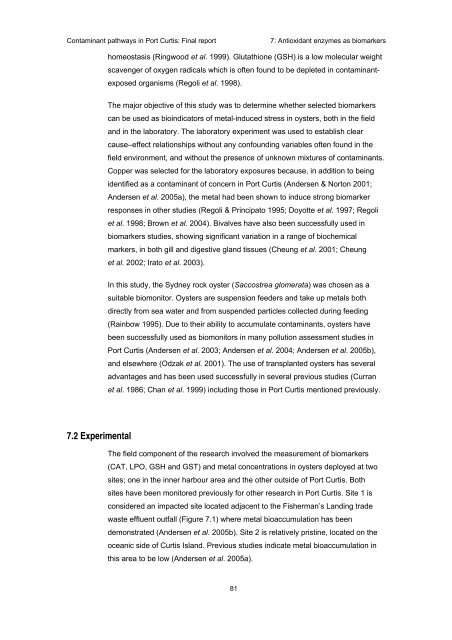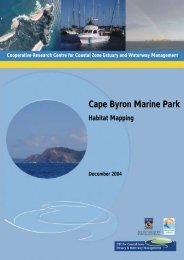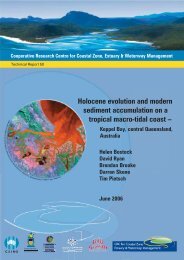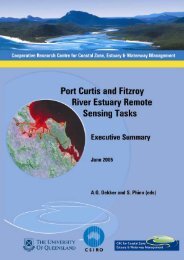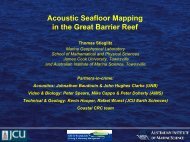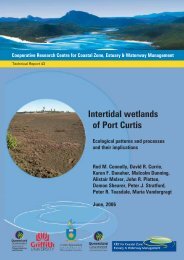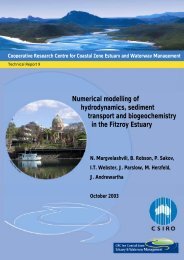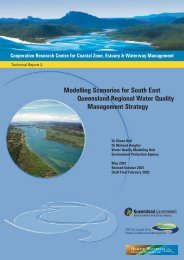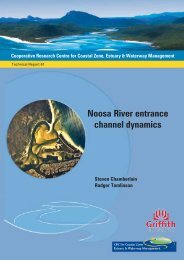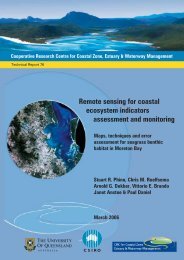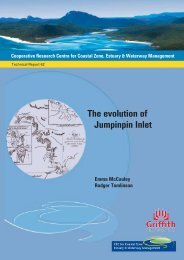Contaminant pathways in Port Curtis: Final report - OzCoasts
Contaminant pathways in Port Curtis: Final report - OzCoasts
Contaminant pathways in Port Curtis: Final report - OzCoasts
You also want an ePaper? Increase the reach of your titles
YUMPU automatically turns print PDFs into web optimized ePapers that Google loves.
<strong>Contam<strong>in</strong>ant</strong> <strong>pathways</strong> <strong>in</strong> <strong>Port</strong> <strong>Curtis</strong>: F<strong>in</strong>al <strong>report</strong>7: Antioxidant enzymes as biomarkershomeostasis (R<strong>in</strong>gwood et al. 1999). Glutathione (GSH) is a low molecular weightscavenger of oxygen radicals which is often found to be depleted <strong>in</strong> contam<strong>in</strong>antexposedorganisms (Regoli et al. 1998).The major objective of this study was to determ<strong>in</strong>e whether selected biomarkerscan be used as bio<strong>in</strong>dicators of metal-<strong>in</strong>duced stress <strong>in</strong> oysters, both <strong>in</strong> the fieldand <strong>in</strong> the laboratory. The laboratory experiment was used to establish clearcause–effect relationships without any confound<strong>in</strong>g variables often found <strong>in</strong> thefield environment, and without the presence of unknown mixtures of contam<strong>in</strong>ants.Copper was selected for the laboratory exposures because, <strong>in</strong> addition to be<strong>in</strong>gidentified as a contam<strong>in</strong>ant of concern <strong>in</strong> <strong>Port</strong> <strong>Curtis</strong> (Andersen & Norton 2001;Andersen et al. 2005a), the metal had been shown to <strong>in</strong>duce strong biomarkerresponses <strong>in</strong> other studies (Regoli & Pr<strong>in</strong>cipato 1995; Doyotte et al. 1997; Regoliet al. 1998; Brown et al. 2004). Bivalves have also been successfully used <strong>in</strong>biomarkers studies, show<strong>in</strong>g significant variation <strong>in</strong> a range of biochemicalmarkers, <strong>in</strong> both gill and digestive gland tissues (Cheung et al. 2001; Cheunget al. 2002; Irato et al. 2003).In this study, the Sydney rock oyster (Saccostrea glomerata) was chosen as asuitable biomonitor. Oysters are suspension feeders and take up metals bothdirectly from sea water and from suspended particles collected dur<strong>in</strong>g feed<strong>in</strong>g(Ra<strong>in</strong>bow 1995). Due to their ability to accumulate contam<strong>in</strong>ants, oysters havebeen successfully used as biomonitors <strong>in</strong> many pollution assessment studies <strong>in</strong><strong>Port</strong> <strong>Curtis</strong> (Andersen et al. 2003; Andersen et al. 2004; Andersen et al. 2005b),and elsewhere (Odzak et al. 2001). The use of transplanted oysters has severaladvantages and has been used successfully <strong>in</strong> several previous studies (Curranet al. 1986; Chan et al. 1999) <strong>in</strong>clud<strong>in</strong>g those <strong>in</strong> <strong>Port</strong> <strong>Curtis</strong> mentioned previously.7.2 ExperimentalThe field component of the research <strong>in</strong>volved the measurement of biomarkers(CAT, LPO, GSH and GST) and metal concentrations <strong>in</strong> oysters deployed at twosites; one <strong>in</strong> the <strong>in</strong>ner harbour area and the other outside of <strong>Port</strong> <strong>Curtis</strong>. Bothsites have been monitored previously for other research <strong>in</strong> <strong>Port</strong> <strong>Curtis</strong>. Site 1 isconsidered an impacted site located adjacent to the Fisherman’s Land<strong>in</strong>g tradewaste effluent outfall (Figure 7.1) where metal bioaccumulation has beendemonstrated (Andersen et al. 2005b). Site 2 is relatively prist<strong>in</strong>e, located on theoceanic side of <strong>Curtis</strong> Island. Previous studies <strong>in</strong>dicate metal bioaccumulation <strong>in</strong>this area to be low (Andersen et al. 2005a).81


